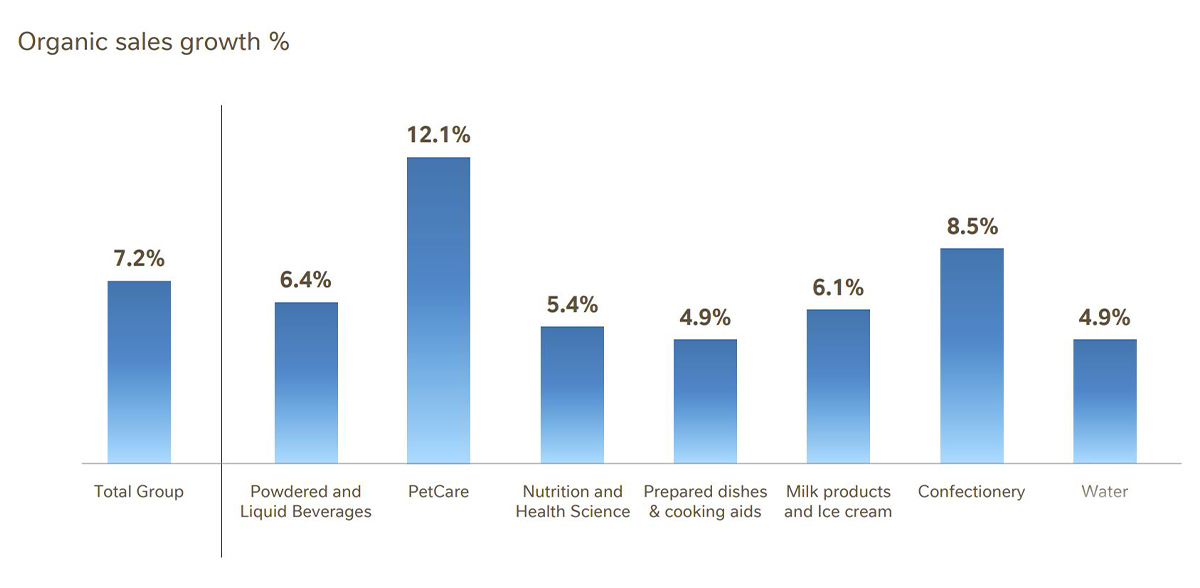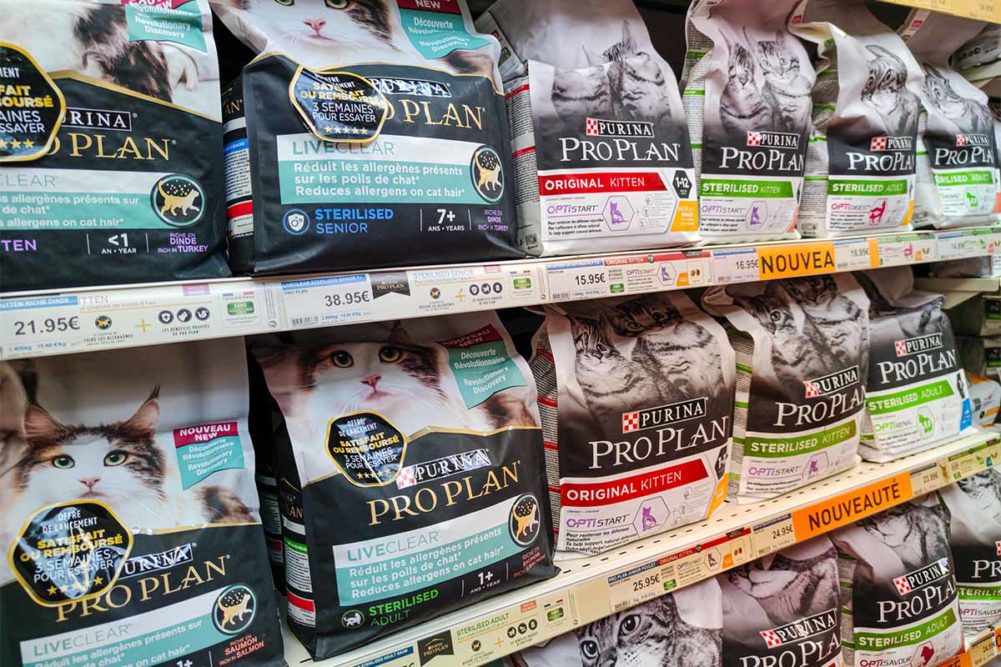VEVEY, SWITZERLAND — Nestlé shared its full-year 2023 financial performance on Feb. 22, once again highlighting Purina PetCare as “the largest contributor to organic growth” for the company. Purina ONE, Purina Pro Plan and Friskies brands led the category with double-digit growth over the year, during which time the company clocked nearly CHF 3 billion ($3.4 billion USD) in sales for the Purina Pro Plan brand alone.
“Pet care posted strong double-digit growth for the fourth consecutive year,” said Mark Schneider, chief executive officer of Nestlé, in the company’s full-year earnings call on Feb. 22. “Science-based premium and veterinary products saw strong sales development… Growth was also supported by continued e-commerce momentum and innovation, particularly for functional products.”
Note: Swiss franc (CHF) to USD currency conversions are based on Feb. 23 conversion rates.
Total sales for Purina in 2023 came to CHF 18.86 billion ($21.41 billion USD), up 4.2% from CHF 18.10 billion ($20.5 billion USD) in 2022. Organic growth was 12.1%, far exceeding all other Nestlé divisions, and real internal growth was reported at 2.8%.
Pricing increased 9.3% for the pet food division, representing the second-highest price hike rate behind Water, which was up 10% over the year.
Purina’s underlying trading operating profit was CHF 3.91 billion ($4.44 billion USD), up 5.4% from CHF $3.71 billion ($4.21 billion USD) year-over-year, and underlying trading profit margin for the division was 20.7% in 2023, up slightly from 20.5% in 2022. This was supported by “growth leverage and improved mix, which more than offset a significant increase in advertising and marketing expenses,” according to Schneider.
Purina was recognized as a key contributor to Nestlé’s performance in Zone North America, driven by Purina ONE, Purina Pro Plan and Friskies brands, and in Zone Europe, driven by Felix, Gourmet and Purina ONE brands. The pet food business saw mid-single-digit growth in Zone Asia, Oceania and Africa (AOA), led by Purina ONE, Supercoat and Felix brands, as well as in Zone Latin America. According to Nestlé, Purina also contributed to mid-single-digit growth in the Japanese market.
In Zone Greater China, Purina gained market share and experienced double-digit growth driven by “new product launches and strong e-commerce momentum.”
“We continue to see a normalization of channel trends across categories with growth supported by momentum in out-of-home and e-commerce particularly for pet care, coffee and Nestlé Health Science,” Schneider said.
Capital expenditures were up roughly CHF 800 million to CHF 6.2 billion ($7.03 billion USD) in 2023, primarily due to investments in the company’s pet care and coffee segments, Schneider added. He noted the company expects CapEx to return to a more normal level, accounting for 5% of its total sales, by 2025.
“We have continued to invest in capital expenditure above historical levels to support the expansion of capacity in pet care and coffee,” Schneider said.
Over the last four years, Nestlé has invested HUF 325 billion (roughly $906.2 million USD) in its pet food manufacturing capabilities in Bük, Hungary, which is expected to increase the company’s annual capacity in the area to half a million tons. The final phase of this investment, which will establish a new pet food plant in Bük, is currently underway.
 Source: Nestlé
Source: Nestlé
Overall, Nestlé reported net sales of nearly CHF 93 billion ($105.50 billion USD) in 2023, down 1.5% from CHF 94.42 billion ($107.12 billion USD) in 2022, with organic growth up 7.2%, real internal growth down 0.3%, and pricing up 7.5%. Underlying trading operating profit for the company was CHF 16.05 billion ($18.21 billion USD) in 2023, down 0.3% from CHF 16.10 billion ($18.27 billion USD) in 2022, and underlying trading operating profit margin was reported at 17.3%, up slightly from 17.1% year-over-year.
“Unprecedented inflation over the last two years has increased pressure on many consumers and impacted demand for food and beverage products,” Schneider stated. “In this challenging context, we delivered strong organic growth and solid margin improvement with increased marketing and other growth investments.
“… Looking to 2024, we are prioritizing volume- and mix-led growth with increased brand support, as we enhance value for consumers through active innovation and renovation, premiumization, affordability and more nutritious options,” he added. “We will continue to focus capital allocation on our fast-growing billionaire brands, which enables us to deliver dependable growth while enhancing brand loyalty.”
Nestlé expects organic sales growth of approximately 4% in fiscal 2024, with underlying earnings per share growing between 6% and 10%.
“To drive market share gains, our key priorities are delighting consumers through differentiated offerings and focusing on superior execution,” Schneider concluded. “We are confident that we have the right strategy, portfolio and capabilities to deliver on our 2025 targets.”
On track to net zero
Nestlé also published its “Creating Shared Value and Sustainability” report on Feb. 22, detailing its progress toward net zero emissions. In 2023, Nestlé reduced its greenhouse gas (GHG) emissions by 13.5% compared to its baseline in 2018, and is on schedule to reach a 20% reduction in GHG emissions by 2025.
The company is also tracking its emissions for specific gases, including methane, which are down 15.3% from 2018 to 2023.
Nestlé continues to implement renewable energy throughout its operations. The company reported 91.9% of electricity used in global manufacturing came from renewable sources by the end of 2023, and will continue on this path toward 100% renewable energy.
Along the value chain, Nestlé is collaborating with farmers and suppliers to reduce its Scope 3 emissions. By the end of 2023, the company noted 15.2% of raw materials were sourced from suppliers using regenerative agriculture and addressing their own emissions. Nestlé hopes to increase this number to 20% by 2025, alongside its efforts to reduce fossil fuel use in packaging and distribution.
“When you look at the 2018 baseline and when you look at the continued growth of the company since and then the 13.5% net reduction, it’s very clear that we have successfully decoupled the growth of the company from the growth of our greenhouse gas emissions, and I think that is very reassuring to see,” Schneider said.
Read more about corporate strategy, financial performance, mergers and acquisitions on our Business page.





